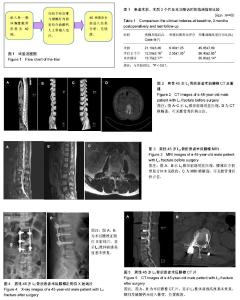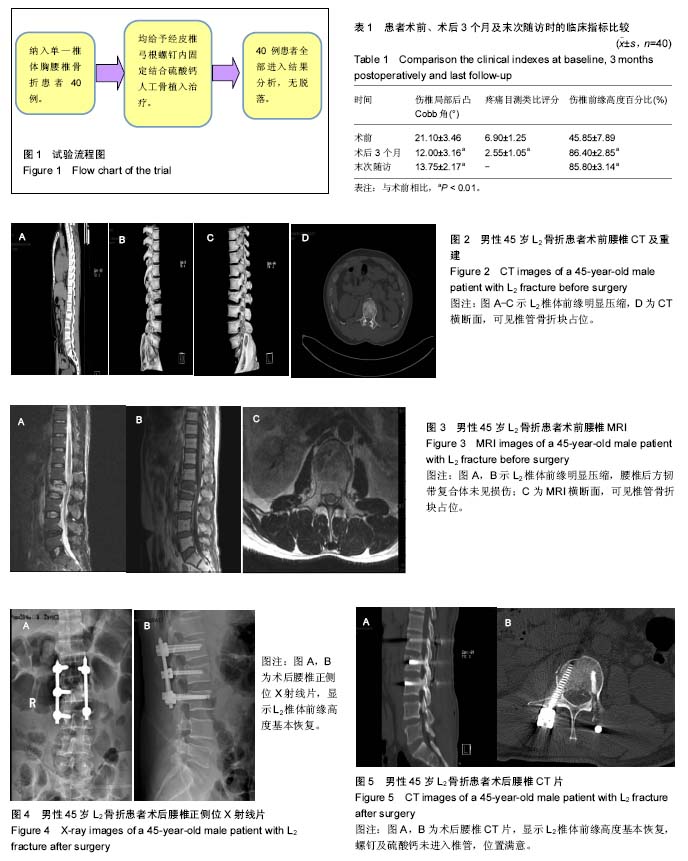Chinese Journal of Tissue Engineering Research ›› 2017, Vol. 21 ›› Issue (23): 3664-3669.doi: 10.3969/j.issn.2095-4344.2017.23.010
Previous Articles Next Articles
Percutaneous pedicle screw fixation combined with calcium sulfate cement for single-level thoracolumbar fracture: a 3-month follow-up
Zhan Fang-biao, Cheng Jun, Feng Shi-long, Xie Li-zhong, Li Bo, Zhang You, Chen Lin
- Department of Orthopedics, Chongqing Three Gorges Central Hospital, Chongqing 404000, China
-
Online:2017-08-18Published:2017-09-01 -
Contact:Cheng Jun, Associate chief physician, Department of Orthopedics, Chongqing Three Gorges Central Hospital, Chongqing 404000, China -
About author:Zhan Fang-biao, Master, Attending physician, Department of Orthopedics, Chongqing Three Gorges Central Hospital, Chongqing 404000, China
CLC Number:
Cite this article
Zhan Fang-biao, Cheng Jun, Feng Shi-long, Xie Li-zhong, Li Bo, Zhang You, Chen Lin. Percutaneous pedicle screw fixation combined with calcium sulfate cement for single-level thoracolumbar fracture: a 3-month follow-up [J]. Chinese Journal of Tissue Engineering Research, 2017, 21(23): 3664-3669.
share this article

2.1 参与者数量分析 按意向性处理,纳入患者共40例,随访过程中无脱落,均进入结果分析。试验流程图见图1。 2.2 围手术期指标观察结果 本组40例患者均获得随访,随访时间14-24个月。手术时间115-150 min,平均 133 min;术中出血量50-85 mL,平均63 mL;住院时间 9-17 d,平均12. 8 d;术后2-4 d(平均3.2 d)可在胸腰骶支具保护下离床活动。术后腰椎CT扫描发现3枚椎弓根螺钉误入椎管,但无脊髓或马尾神经损伤等并发症;无切口感染,切口积血,内固定断裂、松动、硫酸钙渗入椎管等术后并发症;术后遗留腰背部轻度疼痛2例。ODI术后3个月、术后末次随访分别为16.3%,4.4%。 2.3 临床指标观察结果 与术前相比,术后3个月随访时,本组患者的伤椎局部后凸Cobb角及疼痛目测类比评分均减小,伤椎前缘高度百分比增加,差异有显著性意义(P < 0.01);末次随访患者骨折愈合率为95%,2例患者末次随访时骨折未愈合,患者对手术主观满意度的优良率为95%。与术后3个月比较,末次随访患者胸腰椎局部矢状位Cobb角、伤椎前缘高度均有丢失,但差异无显著性意义(P > 0.05),见表1。 2.4 典型病例分析 男性患者,45岁,因交通事故伤6 h入院。L2椎体爆裂骨折A3. 1型,影像学资料见L2椎体前缘明显压缩,椎管内可见骨折块占位。采用经皮椎弓根螺钉置入内固定结合硫酸钙人工骨治疗,术后患者椎体高度基本恢复。影像学资料见图2-5。 2.5 不良事件 本组40例患者中有3例术后腰椎CT扫描发现螺钉误入椎管,但术后围手术期、术后3个月及术后末次随访均未发现明显神经症状。所有患者术后均无切口感染,切口积血等并发症。术后2例患者遗留腰背部轻度疼痛,2例患者末次随访时骨折未愈合。所有患者随访期间未出现螺钉松动、断裂。 2.6 可能影响结果的因素 本研究40例患者手术并非由同一手术医生完成,因此术中出血量、手术时间及椎弓根螺钉置入准确率可能有人为偏倚。本组研究量少,为回顾性研究,患者对手术满意率可能受其他非手术因素的影响(如随访时患者心理状态、患者对医生、护士以及治疗的满意度等)。"

| [1] Hu R,Mustard CA, Burs C.Epeidemiology of incident spinal fracture in a complete population. Spine(Phila Pa 1976). 1996;21:492-499.[2] 杨民,徐祝军,丁国正,等. 后路椎弓根螺钉内固定治疗相邻两节段胸腰椎骨折[J]. 中华创伤杂志,2012,28(6):500-504. [3] 钟远鸣,付拴虎,李智斐,等. 单双侧椎弓根螺钉内固定并后路腰 椎体间融合修复腰椎退行性疾病的系统评价[J]. 中国组织工程研究,2016,20(9):1353-1360.[4] Fuentes S,Blondel B,Metellus P, et al. Percutaneous kyphoplasty and pedicle screw fixation for the management of thoracolumbar burst fractures. Eur Spine J. 2010;19: 1281-1287.[5] Rahamimov N, Mulla H, Shani A, et al. Percutaneous augmented instrumentation of unstable thoracolumbar burst fractures. Eur Spine J. 2012;21:850-854. [6] Wild MH, Glees M, Plieschnegger C, et al. Five-year follow-up examination after purely minimally invasive posterior stabilization of thoracolumbar fractures: a comparison of minimally invasive percutaneously and conventionally open treated patients. Arch Orthop Trauma Surg. 2007;127: 335-343.[7] Ni WF, Huang YX, Chi YL, et al. Percutaneous pedicle screw fixation for neurologic intact thoracolumbar burst fractures. J Spinal Disord Tech. 2010;23:530-537.[8] Samama CM, Langeron O, Rosencher N, et al. Aprotinin versus placebo in major orthopedic surgery: a randomized, doubleblinded, dose-ranging study. Anesth Analg. 2002;95: 287-293. [9] Koutsoumbelis S, Hughes AP, Girardi FP, et al. Risk factors for postoperative infection following posterior lumbar instrumented arthrodesis. J Bone Joint Surg Am. 2011;93: 1627-1633.[10] Schoenfeld AJ, Ochoa LM, Bader JO, et al. Risk factors for immediate postoperative complications and mortality following spine surgery: a study of 3475 patients from the National surgical quality improvement program. J Bone Joint Surg Am.2011;93:1577-1582. [11] Gejo R, Matsui H, Kawaguchi Y, et al. Serial changes in trunk muscle performance after posterior lumbar surgery. Spine. 1999;24: 1023-1028. [12] Kim DY, Lee SH, Chung SK, et al. Comparison of multifidus muscle atrophy and trunk extension muscle strength: percutaneous versus open pedicle screw fixation. Spine. 2005;30:123-129. [13] Kumbhare D, Parkinson W, Dunlop B. Validity of serum creatine kinase as a measure of muscle injury produced by lumbar surgery. J Spinal Disord Tech.2008;21(1):49-54.[14] Lehmann W, Ushmaev A, Ruecker A, et al. Comparison of open versus percutaneous pedicle screw insertion in a sheep model. Eur Spine J.2008;17:857-863.[15] Foley KT, Gupta SK, Justis JR, et al . Percutaneous pedicle screw fixation of the lumbar spine. Neurosurg Focus. 2001; 10(4):1-8.[16] Lee JK, Jang JW, Kim TW, et al. Percutaneous short-segment pedicle screw placement without fusion in the treatment of thoraclumbar burst fractures: is it effective? Comparative sdudy with opne short-segment pedicle screw fixation with posterolateral fusion. Acta Neurochir. 2013;155(12): 2305-2312.[17] Vaccaro AR,Lehman RA Jr,Hurlbert RJ,et al. A new classification of thorocolumbar injuries:the importance of injury morphology,the integrity of the posterior ligamentous complex,and neurologic status. Spine. 2005;30(20): 2325-2333.[18] Huskisson EC. Measurement of pain. Lancet. 1974; 2(7889): 1127-1131. [19] Fairbank JC. The Oswestry low back pain disability questionnaire. Physiotherapy. 1980;66(8):271-273. [20] Fairbank JC, Pynsent PB. The oswestry disability index. Spine (Phila Pa 1976). 2000; 25(22):2940-2952;discussion 2952.[21] 高生,李慧章,席平昌,等.硫酸钙椎体成形术联合椎弓根钉内固定治疗创伤性胸腰椎骨折的前瞻性研究[J].中国骨与关节损伤杂志, 2012,27(7):586-588.[22] Vaccaro AR, Lehman RA, Hurlbert RJ, et al. A new classification of thoracolumbar injuries: the importance of of injury morphology, the integrity of the posterior ligamentous complex, and neurologic status. Spine (Philapa 1976). 2005; 30(20):2325-2333.[23] Siebenga J, Leferink VJM, Segers MJM, et al. Treatment of traumatic thoracolumbar spine fractures: a multicenter prospective randomized study of operative versus nonsurgical treatment. Spine. 2006;31:2881-2890. [24] Weber BR, Grod D, Dvorak J, et al. Posterior surgical approach to the lumbar spine and its effect on the multifidus muscle. Spine. 1997;22:1765-1772.[25] Kim DY, Lee SH, Chung SK, et al. Comparison of multifidus muscle atrophy and trunk extension muscle strength: percutaneous versus open pedicle screw fixation. Spine. 2004;30:123-129.[26] Lee JK,Jang JW,Kim TW,et al. Percutaneous shon—segment pedicle screw placement without fusion in the treatment 0f thomcolumbar burst fractures: is it effective? Comparative study with open short-sellent pedicle screw fixation with posterolateral fusion. Acta NeuIochir. 2013;155(12): 2305-2312.[27] 李长青,罗刚,周跃,等.新型微创经皮椎弓根螺钉内固定治疗胸腰椎骨折[J].中华创伤杂志,2009,25(6):522-525.[28] Tinelli M, Matschke S, Adams M, et al. Sudaa.Correct positioning of pedicle screws with a percutaneous minimal invasive system in spine trauma.Orthop Traumatol Surg Res. 2014;100:389-393.[29] Proietti L, Scaramuzzo L, Schirò GR, et al. Tamburrelli Posterior percutaneous reduction and fixation of thoraco-lumbar burst fractures.Orthop Traumatol Surg Res. 2014;100:455-460.[30] 王洪伟,周跃,李长青,等.经皮椎弓根螺钉内固定治疗胸 腰椎骨折的生物力学及临床研究[J].中华骨科杂志,201l,31(9): 932-937.[31] 王洪伟,周跃,李长青,等.经伤椎与跨伤椎万向钉置钉固定脊柱骨折的生物力学对比研究[J].中华创伤杂志, 20l0,26(12): 1105-1108.[32] Tezeren G, Kuru I. Posterior fixation of thoracolumbar burst fracture: shout-segment pedicle fixation versus long segment instumenation.J spinal Disord Tech. 2005;188(6):485-488.[33] Liao JC, Fan KF, Keorochana G, et al. Transpedicular grafting after short-segment pedicle instrumentation for thoracolumbar burst fracture: calcium sulfate cement versus autogenous iliac bone graft. Spine. 2010;35(15):1482-1488.[34] Liao JC, Fan KF, Chen WJ, et al. Posterior instrumentation with transpedicular calcium sulphate graft for thoracolumbar burst fracture. Int Orthop. 2009;33(6):1669-1675.[35] Walsh WR, Morberg P, Yu Y, et al. Response of a calcium sulfate bone graft substitute in a confined cancellous defect. Clin Orthop Relat Res. 2003;406(1):228-236. [36] Hu GF, Xiao LW, Fu H, et al. Study on injectable and degradable cement of calcium sulphate and calcium phosphate for bone repair. J Mater Sci Mater Med. 2010; 21(2):627-634.[37] Bu BX, Wang MJ, Liu WF, et al. Short-segment posterior instrumentation combined with calcium sulfate cement vertebroplasty for thoracolumbar compression fractures: Radiographic outcomes including nonunion and other complications.Orthop Traumatol Surg Res. 2015;101: 227-233. |
| [1] | Li Rui, Shi Wen, Yang Shicai, Lü Linwei, Zhang Chunqiu. Effect of splintage and Shenxiaosan cataplasm on fracture healing in rabbits with radial fracture model [J]. Chinese Journal of Tissue Engineering Research, 2022, 26(9): 1329-1333. |
| [2] | Yao Xiaoling, Peng Jiancheng, Xu Yuerong, Yang Zhidong, Zhang Shuncong. Variable-angle zero-notch anterior interbody fusion system in the treatment of cervical spondylotic myelopathy: 30-month follow-up [J]. Chinese Journal of Tissue Engineering Research, 2022, 26(9): 1377-1382. |
| [3] | Jiang Huanchang, Zhang Zhaofei, Liang De, Jiang Xiaobing, Yang Xiaodong, Liu Zhixiang. Comparison of advantages between unilateral multidirectional curved and straight vertebroplasty in the treatment of thoracolumbar osteoporotic vertebral compression fracture [J]. Chinese Journal of Tissue Engineering Research, 2022, 26(9): 1407-1411. |
| [4] | An Weizheng, He Xiao, Ren Shuai, Liu Jianyu. Potential of muscle-derived stem cells in peripheral nerve regeneration [J]. Chinese Journal of Tissue Engineering Research, 2022, 26(7): 1130-1136. |
| [5] | Zhang Jinglin, Leng Min, Zhu Boheng, Wang Hong. Mechanism and application of stem cell-derived exosomes in promoting diabetic wound healing [J]. Chinese Journal of Tissue Engineering Research, 2022, 26(7): 1113-1118. |
| [6] | Song Jiawei, Yang Yongdong, Yu Xing, Yang Jizhou, Wang Fengxian, Qu Yi, Bi Lianyong. Mid-term effect of Isobar EVO non-fusion dynamic fixation in the treatment of adjacent segment disease after lumbar fusion [J]. Chinese Journal of Tissue Engineering Research, 2022, 26(6): 908-913. |
| [7] | Chen Xiaoxu, Luo Yaxin, Bi Haoran, Yang Kun. Preparation and application of acellular scaffold in tissue engineering and regenerative medicine [J]. Chinese Journal of Tissue Engineering Research, 2022, 26(4): 591-596. |
| [8] | Kang Kunlong, Wang Xintao. Research hotspot of biological scaffold materials promoting osteogenic differentiation of bone marrow mesenchymal stem cells [J]. Chinese Journal of Tissue Engineering Research, 2022, 26(4): 597-603. |
| [9] | Shen Jiahua, Fu Yong. Application of graphene-based nanomaterials in stem cells [J]. Chinese Journal of Tissue Engineering Research, 2022, 26(4): 604-609. |
| [10] | Zhang Tong, Cai Jinchi, Yuan Zhifa, Zhao Haiyan, Han Xingwen, Wang Wenji. Hyaluronic acid-based composite hydrogel in cartilage injury caused by osteoarthritis: application and mechanism [J]. Chinese Journal of Tissue Engineering Research, 2022, 26(4): 617-625. |
| [11] | Li Hui, Chen Lianglong. Application and characteristics of bone graft materials in the treatment of spinal tuberculosis [J]. Chinese Journal of Tissue Engineering Research, 2022, 26(4): 626-630. |
| [12] | Gao Cangjian, Yang Zhen, Liu Shuyun, Li Hao, Fu Liwei, Zhao Tianyuan, Chen Wei, Liao Zhiyao, Li Pinxue, Sui Xiang, Guo Quanyi. Electrospinning for rotator cuff repair [J]. Chinese Journal of Tissue Engineering Research, 2022, 26(4): 637-642. |
| [13] | He Yunying, Li Lingjie, Zhang Shuqi, Li Yuzhou, Yang Sheng, Ji Ping. Method of constructing cell spheroids based on agarose and polyacrylic molds [J]. Chinese Journal of Tissue Engineering Research, 2022, 26(4): 553-559. |
| [14] | He Guanyu, Xu Baoshan, Du Lilong, Zhang Tongxing, Huo Zhenxin, Shen Li. Biomimetic orientated microchannel annulus fibrosus scaffold constructed by silk fibroin [J]. Chinese Journal of Tissue Engineering Research, 2022, 26(4): 560-566. |
| [15] | Guan Jian, Jia Yanfei, Zhang Baoxin , Zhao Guozhong. Application of 4D bioprinting in tissue engineering [J]. Chinese Journal of Tissue Engineering Research, 2022, 26(3): 446-455. |
| Viewed | ||||||
|
Full text |
|
|||||
|
Abstract |
|
|||||